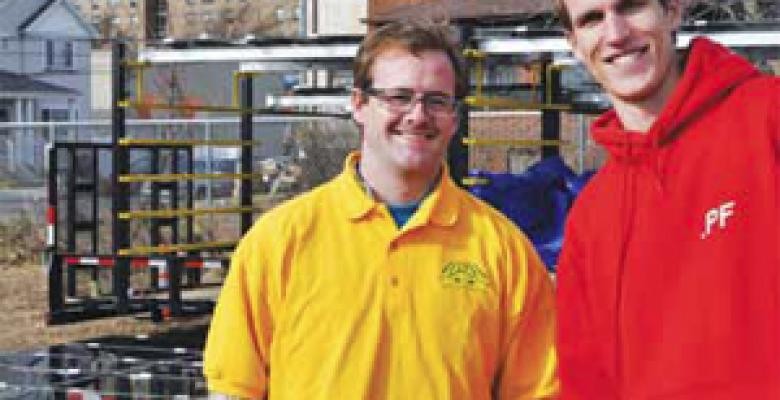Two Engineers Harness Solar Power to Help Sandy Victims

Back in 2010, when graduation still seemed remote and intangible, Rob van Haaren and Garrett Fitzgerald agreed to celebrate their Ph.Ds—whenever they might finish—by piloting a pair of motorcycles from New York City to California. Van Haaren was from Holland, and he wanted to see the country.
Of course, their plan had a unique twist that seemed only appropriate for two doctoral candidates in earth and environmental engineering, who share a passion for renewable energy and low-impact living: Van Haaren, 25, and Fitzgerald, 27 planned to consume no gasoline during their cross-country odyssey. Instead, they would modify electric powered vehicles, build solar arrays they could tow behind them in small trailers to harvest the sun’s energy, and recharge their rigs while they give demonstrations about the vehicle’s systems.
Graduation is finally here for Fitzgerald—van Haaren will follow next fall—and the pair’s ambitious plan hasn’t exactly proceeded as expected. And thank God it hasn’t—just ask the hundreds of Hurricane Sandy victims relying on the pair’s charging station to power the lights, phone chargers, refrigerators, computers and clinic housed inside the St. Gertrude Parish and Youth Center in Far Rockaway Beach, Queens.
“It was always about educational outreach,” Fitzgerald says. “But we never could have predicted this.” Says van Haaren, “Sandy came obviously as a horrible storm, but for us it was a good way to make use of this system.”
When the pair initially dreamed up their cross-country idea, neither of the two students had even built anything solar. Their dissertations also had little to do with the project. Fitzgerald was focused on finding ways to permanently store carbon dioxide in the ground or permafrost areas. Van Haaren specialized in finding ways to integrate renewable energy sources into the electricity grids.
Yet they dove in with enthusiasm in 2011, after months of discussing the idea, they decided first to jettison the motorcycles in favor of an electric car, and then set up a website, wrote letters and lobbied potential sponsors. In the end, they raised about $14,000 from supporters and about $21,000 in donated solar panels and electronics from corporate sponsors, including solar panel manufacturer First Solar, and a company called Outback Power.
In summer 2012 they mounted their portable solar array, which has 72 panels and measures 20 feet by 60 feet when fully deployed, on a modified landscaping trailer. They believed it would be capable of charging 110 volt and 220 volt systems—enough power for about 200 miles of driving on a sunny day. To test it out, they hooked up with an electric vehicle advocacy group called “Driving Congress Green,” towed their rig to Hershey, Penn. to provide free power to food vendors at a FarmAid concert site. The pair continued to tag along with the organization afterwards, displaying their solar arrays and charging their electric vehicles at events held in statehouses across the northeast and South.
Then Hurricane Sandy hit and a colleague asked for help. Van Haaren and Fitzgerald towed their vehicle down to St. Gertrude’s, where relief workers were handing out food, water and blankets and desperately needed power.
“Before us the power was being provided by generators,” Fitzgerald says. “But there was a fuel shortage going on, so it was not a steady supply of electricity.”
On Thanksgiving, their Columbia rig cranked out enough juice to feed 150 people at a solar-powered turkey dinner.
As power returned, Van Haaren and Fitzgerald were contacted by organizers working with the Museum of Modern Art and PS1. They agreed to move their solar array to Rockaway Beach to power an art installation and public space aimed at providing a gathering place for local residents and raising awareness about extreme weather events.
Fitzgerald already has a job lined up at the Rocky Mountain Institute consulting on renewable energy related fields. Van Haaren is starting a company, called DivvySolar.com, that will help people invest in solar installations.
As for their road trip? Prospects remain hazy. “Everything about the system works, we just need to locate the vehicle to do it,” he says. “If we can’t do it this summer, we will just go straight in to the working world.”